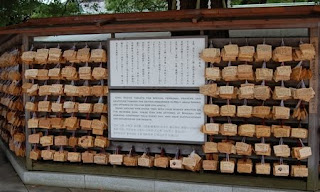With the knowledge that the de Mortillet collection has a significant amount of religious objects, I have decided to research into the symbolism of saints. Saints are a main feature of the votives and have many offerings and meanings devoted to them.
Maybe we could use use this as inspiration when designing our own pieces.
A few examples of Saints and their symbols:
St Agatha - Gold pincers on a red field
St Agnes - White lamb, gold book, on a red field
St Alban - A gold saltire on a blue field
St Alphege - Gold axe-head on silver handle, and field of red
St Sebastian - Gold arrows on a red field
St Romuald - A gold ladder on a black field
St Stephen - A gold palm branch, silver stones, on a red field
St Thomas Aquinas - A gold sun in splendour with the eye, on a black field
Other symbols include:
crosses
stars
flowers, fruits, trees
Flowers, fruit, trees
Acacia - Immortality of the soul
Almond - Divine approval of favour, (St Mary the Virgin)
Apple - Salvation, sin
Carnation - (Red), Pure love
Cherry - Good works
Daisy - Innocence
Iris - The sorrow of the Virgin for the Passion of the Lord Jesus Christ
Ivy - Life external, Fidelity
Laurel - Triumph, eternity
Lily - Purity
Narcissus - Divine love
Oak - Faith and endurance
Olive branch - Peace
Palm - Spiritual victory
Pomegranate - Fertility
Poppy - Fertility
Violet - Humility
Wheat - Bountifulness
Significance of colour
Black - solemity, negatation, sickness, death
Black and White - Humility, purity of life
Blue - Heavenly love, unveiling of truth, St Mary
Brown - Spititual death and degradation
Gold (see white)
Grey - Ashes, humility, mourning
Green - Spring, triumph of life over death,charity, good works, hope
Purple - Royalty, Imperial power
Red - Martyred saints, love, hate, sovereign power
Violet - Love, truth, passion, suffering
White (Gold) - Innocence of soul, purity, holiness of life, Christmas, Easter, etc.
Yellow - Dingy:Infernal light, degradation,jealousy, treason, deceit

















































